Workers Compensation Options for General Contractors
See How We're Different
or call us: 888-988-2347
Types of Contractors We Serve
Jonathan Behr
Owner of Contractor Insurance Pros by Behr Insurance Services
Index
Why Workers Compensation Matters for General Contractors
Types of Workers Compensation Coverage for General Contractors
Key Trends Affecting Workers Compensation Costs and Claims
Strategies for General Contractors to Optimize Workers Compensation Coverage
Understanding Workers Compensation Coverage Limits and Benefits
Contact Us
Phone
Location
Simi Valley, CA 93065
The Woodlands, TX 77382
Katy, TX 77494
Construction sites can be unpredictable. One moment, everything runs smoothly; the next, an accident can change everything. In 2025, construction workers made up 18.5% of all workplace fatalities in the U.S., a stark reminder of the risks involved in this industry. For general contractors, securing the right workers compensation coverage is not just a regulatory requirement-it is a crucial safeguard for their workforce and business stability. Understanding the options available and the factors influencing workers comp today can help contractors make informed decisions that protect their teams and bottom lines.
Construction insurance industry statistics highlight the growing importance of this coverage in the face of ongoing workplace hazards.
Why Workers Compensation Matters for General Contractors
General contractors oversee multiple subcontractors and workers on site, each exposed to a variety of hazards. Workers compensation insurance covers medical expenses, lost wages, and rehabilitation costs if someone gets injured on the job. Without it, contractors could face costly lawsuits or crippling financial losses.
The construction sector’s high injury rates make this coverage essential. A 2025 study found that 44% of construction injuries over the past five years involved workers in their first year on the job. New hires often lack experience, increasing their risk of accidents. This statistic underscores the need for not only insurance but also targeted safety training to reduce claims and protect workers. Implementing comprehensive onboarding programs that include safety protocols and hands-on training can significantly mitigate risks. Additionally, regular safety meetings and drills can reinforce a culture of safety, ensuring that even seasoned workers remain vigilant and informed about the latest safety practices and regulations.
Beyond legal compliance, workers comp insurance supports workforce morale and retention. Knowing they have coverage if injured encourages workers to stay engaged and focused on safety. This is especially important considering ongoing labor shortages driven by an aging workforce, as noted by Becky Pinto, president of Arrowhead’s Workers’ Compensation Division. Contractors who prioritize safety and coverage can better attract and retain skilled labor. Moreover, offering additional benefits related to health and wellness, such as mental health resources and ergonomic assessments, can further enhance employee satisfaction. When workers feel valued and secure in their jobs, they are more likely to contribute positively to the work environment, leading to increased productivity and a stronger team dynamic.

Types of Workers Compensation Coverage for General Contractors
General contractors have several options when it comes to workers compensation insurance. Choosing the right type depends on the size of the business, number of employees, subcontractor relationships, and state regulations.
Standard Workers Compensation Insurance
This is the most common form of coverage, providing benefits for medical care, lost wages, and disability resulting from workplace injuries. It typically covers employees directly on the contractor’s payroll but may exclude subcontractors unless specifically included.
Premiums are calculated based on payroll size, job classifications, and claims history. The National Council on Compensation Insurance (NCCI) recently recommended premium rate reductions in many states, reflecting improved safety and fewer severe claims. This trend can offer cost relief to contractors investing in workplace safety programs. NCCI’s 2024 rate recommendations highlight these positive developments.
Moreover, many states have implemented safety incentive programs that reward contractors for maintaining low injury rates. These programs can provide additional financial benefits and encourage a culture of safety within the workplace. By prioritizing safety, contractors not only protect their employees but also enhance their reputation, making them more attractive to potential clients and skilled workers.
Subcontractor Coverage Options
General contractors often rely on subcontractors who may carry their own workers comp policies. However, verifying coverage and managing liability can be complicated. Some contractors opt to include subcontractors under their own policy through endorsements or separate agreements. This approach can simplify claims handling but may increase premiums.
Alternatively, contractors can require subcontractors to provide certificates of insurance proving adequate coverage. This reduces the contractor’s exposure but requires diligent oversight to avoid gaps. Regular audits and checks on subcontractor insurance can mitigate risks and ensure compliance, but it also demands a proactive approach to management and communication.
In addition, some contractors may choose to implement a subcontractor prequalification process, where they assess the financial stability and safety records of potential subcontractors before hiring them. This not only helps in selecting reliable partners but also fosters a collaborative environment focused on safety and compliance, ultimately leading to fewer incidents on the job site.
Alternative and Self-Insurance Programs
Larger contractors may explore self-insurance or group-funded programs. Self-insurance allows a company to pay claims directly rather than purchasing traditional insurance. This option demands strong financial reserves and claims management expertise.
Group-funded programs pool resources among multiple contractors to share risk and reduce costs. These arrangements often include safety training and loss control services, which can help lower injury rates and claims severity. By participating in such programs, contractors can benefit from shared knowledge and resources, enhancing their overall safety protocols and risk management strategies.
Furthermore, self-insured contractors often develop tailored safety programs that specifically address the unique risks associated with their operations. This customization can lead to more effective training and prevention strategies, ultimately resulting in a safer work environment and reduced claims over time. As the construction industry continues to evolve, embracing innovative insurance solutions can provide a competitive edge while safeguarding both workers and the bottom line.
Key Trends Affecting Workers Compensation Costs and Claims
Several factors are shaping the workers compensation landscape for general contractors in 2025 and beyond. Understanding these trends can help contractors anticipate changes and adjust their coverage strategies accordingly.
Rising Medical Costs and Indemnity Claims
Medical inflation continues to push up the cost of workers comp claims. In construction, the average indemnity claim reached $51,500 in 2025, reflecting longer recovery times and more expensive treatments. These higher claim costs put pressure on insurance premiums and highlight the value of proactive safety measures to prevent injuries.
Christian Citarella, an actuary with the NH Insurance Department, notes that declining medical expenses in some sectors result from safety improvements. However, construction still faces challenges due to the nature of its work and injury severity. Investing in safety training and equipment remains the best way to control claims costs. Additionally, the integration of technology, such as wearable devices that monitor worker health and safety, is becoming increasingly important. These innovations can provide real-time data to help identify potential hazards before they lead to accidents, further mitigating risk and reducing claims.
Injury Risk for New Workers
New employees are particularly vulnerable. Studies show that 35% of all workplace injuries occur during a worker’s first year, leading to millions of missed workdays. For construction, nearly half of injuries involve first-year workers. This risk factor calls for targeted onboarding programs, mentoring, and ongoing safety education to reduce incidents.
Contractors who implement robust safety protocols for new hires not only protect their workers but also reduce the frequency and severity of claims. This can translate into lower premiums and better overall risk management. Furthermore, incorporating hands-on training sessions that simulate real job site conditions can significantly enhance new workers' confidence and competence. Engaging experienced workers as mentors can also foster a culture of safety and accountability, ensuring that new hires are well-equipped to handle the challenges of their roles.
Labor Shortages and Workforce Demographics
The construction industry faces persistent labor shortages fueled by an aging workforce. Becky Pinto highlights that this demographic shift will continue to squeeze the workers compensation market as fewer skilled workers are available and replacement costs rise. Contractors may need to offer enhanced safety programs and benefits to attract younger workers.
Labor shortages can also increase workloads and fatigue, raising injury risks. Balancing staffing levels with safety priorities is critical to maintaining a healthy workforce and controlling workers comp exposure. Moreover, the industry is witnessing a shift in workforce demographics, with a growing emphasis on diversity and inclusion. Embracing a more diverse workforce not only brings fresh perspectives but can also enhance safety outcomes, as varied experiences and backgrounds often lead to innovative problem-solving approaches. Contractors who invest in creating an inclusive environment may find themselves better positioned to attract talent and reduce turnover, ultimately contributing to a more stable and safer work environment.
Strategies for General Contractors to Optimize Workers Compensation Coverage
Choosing the right workers compensation insurance is only part of the equation. General contractors can take several steps to improve safety, manage claims, and control costs.
Invest in Safety Training and Culture
Safety programs tailored to the construction environment reduce injuries and claims. Emphasizing training for new hires, regular toolbox talks, and clear communication about hazards creates a culture where safety is everyone’s responsibility. This approach aligns with findings that proactive safety measures help keep workers comp costs down.
Providing personal protective equipment and enforcing its use is equally important. Contractors who demonstrate a commitment to safety often benefit from lower premiums and fewer disruptions. Furthermore, fostering an open dialogue about safety concerns encourages workers to report potential hazards without fear of reprisal, which can lead to early interventions that prevent accidents. Regular safety audits and feedback sessions can also help identify areas for improvement, ensuring that safety remains a top priority on every job site.
Use Technology to Monitor and Prevent Risks
Modern technology offers tools like wearable devices, site sensors, and mobile apps that track worker movements and environmental conditions. These innovations help identify hazards before accidents occur and provide data to support safety improvements.
Integrating technology into safety programs can also streamline incident reporting and claims management, reducing administrative burdens and speeding up recovery. For instance, the use of drones for site inspections can provide real-time data on site conditions, while virtual reality training programs can simulate hazardous scenarios, allowing workers to practice responses in a safe environment. By leveraging these technologies, contractors can not only enhance safety protocols but also cultivate a more engaged workforce that understands the importance of risk management.
Work Closely with Insurance Providers and Brokers
Insurance professionals can help contractors navigate coverage options, identify cost-saving opportunities, and implement loss control strategies. Regular reviews of policy terms, classifications, and claims history ensure that coverage remains appropriate as the business evolves.
Some insurers offer premium discounts or rebates for contractors who demonstrate strong safety performance. Engaging with carriers proactively can unlock these benefits. Additionally, establishing a strong relationship with insurance brokers can facilitate access to specialized programs designed for the construction industry, such as experience modification rate (EMR) reviews, which can significantly impact premium costs. By staying informed about industry trends and legislative changes, contractors can better position themselves to take advantage of new opportunities for savings and enhanced coverage options.

Understanding Workers Compensation Coverage Limits and Benefits
General contractors should be clear on what workers compensation insurance covers and where gaps may exist. Typically, policies include medical benefits, wage replacement, disability payments, and death benefits. However, coverage limits and exclusions vary by state and insurer.
Contractors need to verify that policies meet state requirements and adequately cover all workers, including subcontractors if applicable. Understanding indemnity limits and how claims affect premiums helps in budgeting and risk planning.
Below is a simple comparison of common workers compensation coverage elements relevant to general contractors:
| Coverage Element | What It Covers | Considerations for Contractors |
|---|---|---|
| Medical Benefits | All necessary medical treatment for work-related injuries | Rising medical costs increase claim expenses; safety reduces claims |
| Wage Replacement | Partial wage payments during disability or recovery | Important for worker retention; affects indemnity claim size |
| Disability Benefits | Compensation for permanent or temporary disability | Severity of injuries impacts long-term costs and premiums |
| Death Benefits | Payments to survivors in case of fatal workplace accidents | Critical in high-risk industries like construction |
| Subcontractor Coverage | May be included or excluded depending on policy terms | Verify coverage to avoid liability gaps |
What General Contractors Should Keep in Mind
Workers compensation insurance is a complex but vital part of running a construction business. The right coverage protects workers and shields contractors from financial shocks. With construction injuries remaining a significant concern, especially among new workers, investing in safety and carefully selecting insurance options pays off.
Staying informed about industry trends, such as the recent premium rate reductions recommended by the NCCI and the impact of rising medical costs, helps contractors anticipate changes and adapt. Combining insurance with strong safety programs and technology creates a resilient operation ready to handle the challenges of construction work.
Additionally, the ongoing effects of the COVID-19 pandemic continue to influence workers compensation claims and market conditions. The Texas Workers' Compensation Market Report highlights how adaptive strategies remain necessary to manage evolving risks and claims patterns.
Frequently Asked Questions
Q: Do general contractors have to carry workers compensation insurance for subcontractors?
A: It depends on state laws and contract terms. Often, subcontractors carry their own coverage, but contractors may choose to include them under their policy or require proof of insurance.
Q: How can new workers be better protected on construction sites?
A: Focused safety training, mentoring, and clear communication about hazards reduce injury risks for new hires, who account for a large share of workplace injuries.
Q: What factors influence workers compensation premiums for general contractors?
Payroll size, job classifications, claims history, and safety programs all affect premium costs. Improved safety can lead to lower rates.
Q: Can technology help reduce workers compensation claims?
Yes. Wearables, sensors, and mobile apps can monitor risks, improve safety, and streamline claims management.
Q: What should contractors do if they face labor shortages?
Enhancing safety, offering competitive benefits, and investing in training can attract and retain workers despite demographic challenges.
Q: Are workers compensation premiums expected to rise or fall?
Recent recommendations from the NCCI suggest some premium rate reductions due to better safety, but rising medical costs may offset these gains in certain sectors.


